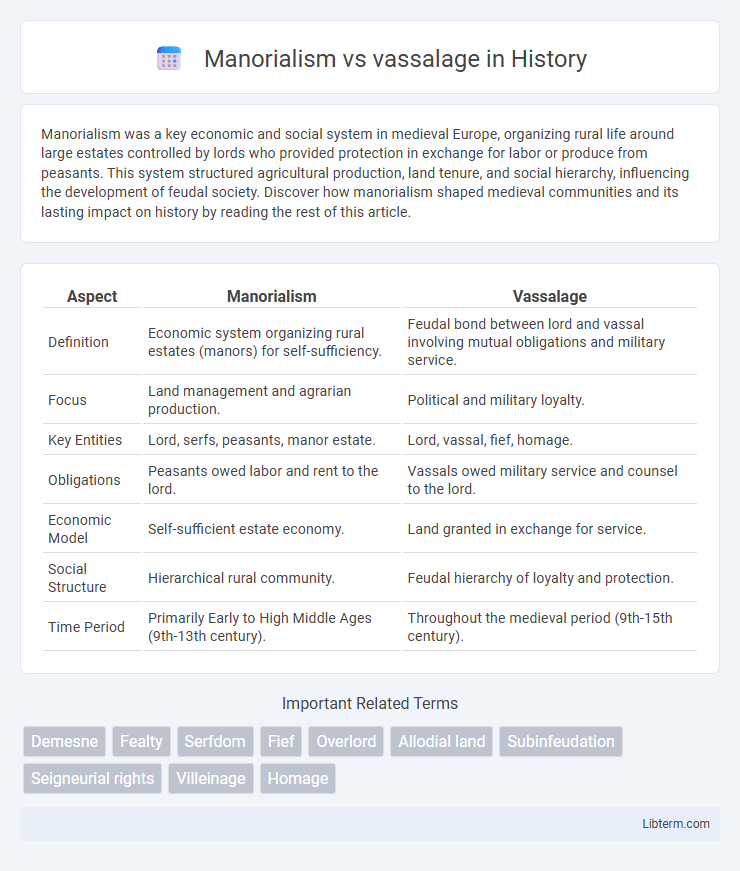Manorialism was a key economic and social system in medieval Europe, organizing rural life around large estates controlled by lords who provided protection in exchange for labor or produce from peasants. This system structured agricultural production, land tenure, and social hierarchy, influencing the development of feudal society. Discover how manorialism shaped medieval communities and its lasting impact on history by reading the rest of this article.
Table of Comparison
| Aspect | Manorialism | Vassalage |
|---|---|---|
| Definition | Economic system organizing rural estates (manors) for self-sufficiency. | Feudal bond between lord and vassal involving mutual obligations and military service. |
| Focus | Land management and agrarian production. | Political and military loyalty. |
| Key Entities | Lord, serfs, peasants, manor estate. | Lord, vassal, fief, homage. |
| Obligations | Peasants owed labor and rent to the lord. | Vassals owed military service and counsel to the lord. |
| Economic Model | Self-sufficient estate economy. | Land granted in exchange for service. |
| Social Structure | Hierarchical rural community. | Feudal hierarchy of loyalty and protection. |
| Time Period | Primarily Early to High Middle Ages (9th-13th century). | Throughout the medieval period (9th-15th century). |
Introduction to Manorialism and Vassalage
Manorialism was a medieval economic system centered around a lord's estate, or manor, where peasants worked the land in exchange for protection and a portion of the produce, emphasizing self-sufficiency and local agriculture. Vassalage, in contrast, was a social and military relationship involving a lord and a vassal, where the vassal pledged loyalty and service, often military, in return for land or protection. These systems defined the hierarchical structure and land tenure in medieval Europe, intertwining economic roles with feudal obligations.
Historical Origins and Development
Manorialism originated in the early medieval period as a socio-economic system organizing rural estates, focusing on agricultural production and the obligations between lords and peasants. Vassalage developed concurrently as a feudal legal framework establishing personal bonds of loyalty and military service between lords and vassals. Both systems evolved from the fragmentation of Carolingian authority, shaping medieval Europe's political and economic structures.
Key Features of Manorialism
Manorialism centered on the economic and social structure of rural estates, where peasants worked the lord's land in exchange for protection and access to common resources. Key features included the lord's demesne, the labor services of serfs, and the self-sufficient nature of the manor with its agriculture, livestock, and mills. This system emphasized local production and hierarchical obligations, contrasting with vassalage, which revolved around feudal military and political allegiance between lords and vassals.
Main Characteristics of Vassalage
Vassalage in medieval Europe was characterized by a hierarchical relationship in which a vassal pledged loyalty and military service to a lord in exchange for protection and land known as a fief. This system involved formal ceremonies of homage and fealty, creating personal bonds of trust and obligation essential to sustaining feudal society. Unlike manorialism, which centered on economic management of estates, vassalage emphasized political and military allegiance within the feudal order.
Social Structure Comparison
Manorialism organized medieval rural society through a hierarchical system centered on the manor, where peasants worked the land under the authority of a lord who owned the estate. Vassalage structured social relationships within the feudal system, emphasizing mutual obligations between lords and vassals, including military service and protection in exchange for land or benefices. The manorial system primarily defined economic and social roles within local communities, while vassalage established political and military bonds across broader feudal networks.
Economic Functions and Impact
Manorialism structured medieval rural economy by organizing agricultural production around large estates controlled by lords who extracted rents and labor from peasants, ensuring local economic stability and resource management. Vassalage functioned as a feudal relationship centered on land tenure and military service, fostering political alliances and securing protection in exchange for economic obligations. The economic impact of manorialism emphasized self-sufficiency and localized production, while vassalage facilitated broader territorial control and wealth redistribution through feudal hierarchies.
Political Authority and Power Relations
Manorialism structured political authority through localized economic control, where lords exercised power over peasants and managed land for agricultural production, reinforcing hierarchical social orders. Vassalage operated within the feudal system, emphasizing mutual obligations between lords and vassals, where political authority was decentralized but maintained through sworn loyalty and military service. Power relations in manorialism were primarily economic and administrative, while vassalage integrated military allegiance and legal responsibilities, shaping medieval governance dynamics.
Roles of Lords, Serfs, and Vassals
Manorialism centered on the lord's control over landed estates where serfs worked the land in exchange for protection and sustenance, while vassalage involved a hierarchical system where vassals pledged military service and loyalty to their lords in return for land or fiefs. Lords in manorialism managed agricultural production and local justice, whereas in vassalage, they granted landholdings and ensured the vassal's military obligations. Serfs were bound to the manor and provided labor, while vassals held semi-independent status with obligations to their lord, reflecting distinct social and economic roles within medieval feudal society.
Decline and Transformation in Medieval Society
Manorialism, centered on the economic organization of rural estates, declined as medieval agricultural productivity increased and trade expanded, weakening the local self-sufficiency that defined the manor. Vassalage, a key feature of feudal military and social hierarchy, transformed as centralized monarchies and standing armies reduced the need for private military service by nobles. These shifts contributed to the rise of more centralized states and a gradual transition from feudal obligations to monetary-based economies in late medieval Europe.
Lasting Legacy and Modern Interpretations
Manorialism established the economic foundation of medieval agrarian societies by organizing rural estates, influencing land tenure and rural social structures in Europe that persist today. Vassalage shaped feudal political hierarchies through reciprocal obligations between lords and vassals, underpinning modern concepts of loyalty and governance in Western legal traditions. Together, their lasting legacy is evident in contemporary property laws and socio-political contracts reflecting medieval constructs of authority and land use.
Manorialism Infographic

 libterm.com
libterm.com